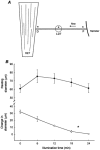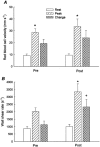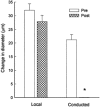Role for endothelial cell conduction in ascending vasodilatation and exercise hyperaemia in hamster skeletal muscle
- PMID: 11691885
- PMCID: PMC2278906
- DOI: 10.1111/j.1469-7793.2001.00937.x
Role for endothelial cell conduction in ascending vasodilatation and exercise hyperaemia in hamster skeletal muscle
Abstract
1. Vasodilatation initiated by contracting skeletal muscle 'ascends' from the arteriolar network to encompass feed arteries. Acetylcholine delivery from a micropipette onto a feed artery evokes hyperpolarisation at the site of application; this signal can conduct through gap junctions along the endothelium to produce vasodilatation. We tested whether conduction along the endothelium contributes to the ascending vasodilatation that occurs in response to muscular exercise. 2. In anaesthetised hamsters, a feed artery (resting diameter 64 +/- 4 microm) supplying the retractor muscle was either stimulated by local microiontophoretic application of acetylcholine or the muscle was contracted rhythmically (once per 2 s, 1-2 min), before and after light-dye treatment (LDT) to disrupt the endothelial cells within a 300 microm-long segment located midway along the vessel. Endothelial cell damage with LDT was confirmed by the local loss of vasodilatation in response to acetylcholine and labelling with propidium iodide. Local vasodilatation in response to acetylcholine applied 500 microm proximal (upstream) or distal (downstream) to the central segment with LDT remained intact. 3. Before LDT, vessel diameter increased by more than 30 % along the entire feed artery (observed 1000 microm upstream from the retractor muscle) in response to distal acetylcholine or muscle contractions. Following LDT, vasodilatation in response to acetylcholine and to muscle contractions encompassed the distal segment but did not travel through the region of endothelial cell damage. At the upstream site, wall shear rate (and luminal shear stress) increased more than 3-fold, with no change in vessel diameter. Thus, flow-induced vasodilatation did not occur. 4. In response to muscle contractions, feed artery blood flow increased nearly 6-fold; this hyperaemic response was reduced by half following the loss of ascending vasodilatation. 5. These findings indicate that rhythmic contractions of skeletal muscle can initiate the conduction of a signal along the endothelium. We propose that this signalling pathway underlies ascending vasodilatation and promotes the full expression of exercise hyperaemia.
Figures





References
-
- Bartlett IS, Segal SS. Resolution of smooth muscle and endothelial pathways for conduction along hamster cheek pouch arterioles. American Journal of Physiology - Heart and Circulatory Physiology. 2000;278:H604–612. - PubMed
-
- Burnstock G, Prosser CL. Conduction in smooth muscles: comparative electrical properties. American Journal of Physiology. 1960;199:553–559. - PubMed
-
- Emerson GG, Segal SS. Endothelial cell pathway for conduction of hyperpolarization and vasodilation along hamster feed artery. Circulation Research. 2000a;86:94–100. - PubMed
Publication types
MeSH terms
Substances
Grants and funding
LinkOut - more resources
Full Text Sources
Medical
Miscellaneous

